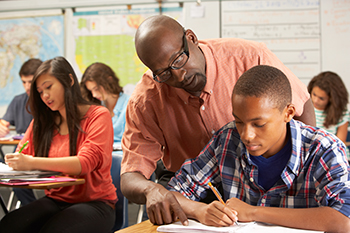
With projects like the Internet Broadcast Project and the
Schools Partnership Projects the UFS helps to improve
education at schools in the Free State.
Photo: iStock
The University of the Free State (UFS) congratulates the Free State and its learners on their outstanding performance in the 2016 matric results. The university, who also plays a role in promoting excellence at school level, is proud of the Free State’s achievement as the best-performing province in the country with a 93,2% pass rate, excluding progressed learners.
“On behalf of the university community I would like to congratulate the Free State MEC of Education, Tate Makgoe, who is also a member of the UFS Council, and the Department of Education in the province on this fine achievement. The UFS is proud to be involved in projects that contribute to the success of the province’s learners. These include the Internet Broadcast Project (IBP) and the Schools Partnership Projects (SPP). The projects help to improve the quality of teaching and help learners to overcome severe domestic conditions in rural areas,” says Prof Nicky Morgan, Acting Vice-Chancellor and Rector of the UFS.
Internet Broadcast Project
The UFS IDEAS Lab in the Department of Open and Distance Learning on the UFS South Campus supports learners in 83 schools through the IBP with the help of academic videos. The project is a collaboration between the university and the Department of Education in the province. It includes support for subjects such as Mathematics, Physical Science, Life Science, Economics, Accounting, and Geography.
A purpose-built school appliance, comprising a projector, speakers, and a PC, is set up at each school, where learners receive video lectures from highly-qualified teachers.
During a function held in Bloemfontein on 5 January 2017 to congratulate performing schools in the province, Mr Makgoe made special mention of the IBP and said that part of the success of the province can be attributed to the project. Many of the top performing schools had learners who participated in the project. One of the districts that forms part of the project, the Xhariep District, was announced as the top performing district in the province, and is second in the country.
Schools Partnership Projects
The SPP focuses on teachers in order to have a more sustainable impact, with 69 schools in the Free State and Eastern Cape being part of it.
It makes use of mentors (30) who assist teachers and headmasters with school management, Mathematics, Physical Science, Accounting, and English as language of learning. The project has an annual budget of more than R15 million – all the funds come from sponsors outside the UFS.
Mentors visit schools and share knowledge, extra material, and technology to improve the standard of teaching. The change has been significant. Matric results and Bachelors pass rates have improved dramatically in these schools.
Another aspect is the identification of learners with potential (so-called first-generation students) to go to university. They are assisted through extra classes and in applying for tertiary education and bursaries.
Many of them currently study at the UFS, and also receive mentorship at university.
Dr Peet Venter, SPP Project Manager, said his team is proud to be part of the process of helping the Free State to become the number one province in the country again.
Both the IBP and SPP was started in 2011 and are managed from the university’s South Campus in Bloemfontein.